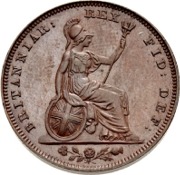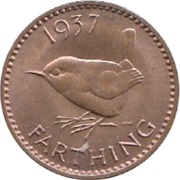 The 1826 Farthing - George IV Proof (Second Issue)
The 1826 Farthing - George IV Proof (Second Issue)1826 bronze proof farthing. Second issue, and both first and second were minted in 1826. A main difference (besides the new portrait) was the first issue has GEORGE IIII and this second issue says GEORGE IV. London mint. Diameter 22mm, weighs 4.81g. SCBC 3825.
The Reverse shows Britannia with helmet, seated on a rock with trident and union shield. Shamrock, rose, and thistle in exergue.
 The Obverse is a laureate bust of King George IV facing left. Date below.
The Obverse is a laureate bust of King George IV facing left. Date below.Image credit: CNGCoins.
Click to Check these on eBay.
As an eBay Partner, We may be compensated if you make a purchase
(scroll to bottom for more)
As an eBay Partner, We may be compensated if you make a purchase
(scroll to bottom for more)
List items on:
Mintage: Not known
Minted at The Royal Mint.
Remember 1826 ?
The Monarch is King George IV. Prime Minister is Robert Jenkinson, 2nd Earl of Liverpool (Conservative) and continues after a June General Election. US President is John Quincy Adams. Thomas Telford builds the Menai Suspension Bridge and the Conway Suspension Bridge, both in Wales. Ludwig van Beethoven is still composing great music.
George IV (1820-1830)
 George IV was King of the United Kingdom of Great Britain and Ireland and of Hanover following the death of his father, George III, on 29 January 1820, until his own death ten years later. George IV had previously ruled as Prince Regent from 1811-1820 due to his father's mental illness.
George IV was King of the United Kingdom of Great Britain and Ireland and of Hanover following the death of his father, George III, on 29 January 1820, until his own death ten years later. George IV had previously ruled as Prince Regent from 1811-1820 due to his father's mental illness.George was married to Caroline of Brunswick and they had a daughter, Princess Charlotte, who died following the birth of a stillborn child. As the second son of George III (Prince Frederick) was childless, following the rules of the monarchy on his death George was succeeded by his brother, William IV.
Note that on coin, George IV is often written as Georgivs IIII.
Category: Farthings
The Farthing was a small British coin that was worth one-quarter of an old penny - 1/960th of a Pound. It's name derives from the Anglo-Saxon feorthing or fourthling, meaning fourth part. It was last minted in 1956. Origins of the English Farthing
Farthings were minted as early as the 13th century under the reign of Edward I, although they may have been minted earlier under Henry III. Early examples are rare. These were small silver coins but they competed with 'cut-coinage' where a penny would be literally cut into four and used as a quarter of a penny. Farthing were minted in silver, copper and tin.
British Farthings
After the Act of the Union in 1707 (which unified England and Scotland), copper farthings were minted on a more regular basis. In 1799 Matthew Boulton started producing farthings in his steam-powered Birmingham factory (famous for making the cartwheel penny and twopence). The reverse was marked '1 FARTHING' which was the first time a denomination had ever appeared on a British or English coin. It was also the first coin to have the date on the same side as the Monarch. Boulton made another batch in 1806 and the Royal Mint took over in 1821. Farthing were made under George IV and William IV and the design was generally that of a small version of a penny, with Britannia on the reverse.
Farthings were minted in most of the years of Victoria's reign. The same obverse dies were used for the copper farthing and the sovereign and probably were used for the gold coin first. Victoria was the only monarch to have two obverses: a 'Bun' head and the Old or 'Veiled' head.
1860: Bronze replaces Copper
By 1860, the government decided to switch from copper to alloys so as to improve the quality of the coinage. Pennies, halfpennies and farthings were struck in bronze, both in Birmingham and at the Royal Mint. Bronze is 95% copper, 4% tin and 1% zinc and this was used with only minor changes until the end of the farthing in 1956.
 Farthings continued to be minted almost every year and the design was the same as the penny (with Britannia on the reverse). There was a pattern design for the Edward VIII farthing in 1936 but none were actually made in production.
Farthings continued to be minted almost every year and the design was the same as the penny (with Britannia on the reverse). There was a pattern design for the Edward VIII farthing in 1936 but none were actually made in production. The Wren and Demonetisation
In 1937 the farthing at long last got it's own unique reverse: a wren, designed by artist Harold Wilson Parker. By the 1950's inflation had eroded the spending power of the farthing (which was just 1/960th of a Pound) and with it the support of the public waned too. Production was discontinued after 1956 and the coin ceased to be legal tender after 31st December 1960.
Which Mint: The Royal Mint
The Royal Mint is the designated place for the UK to mint coins. It dates back well over 1000 years and is a Government-owned company. Formed in the reign of Alfred the Great about the year 886, during the period 1279-1812 it was generally referred to as The Tower Mint as it was housed at the Tower of London. The Master of The Royal Mint has included famous figures such as Sir Isaac Newton.
Since 2010 it has operated as Royal Mint Ltd, a company owned by HM Treasury, under an exclusive contract to supply all coinage for the UK although it also produces medals and coins for other countries. It is currently located at Llantrisant, Wales.
Country of Origin: United Kingdom
The United Kingdom (UK) is the Union of England, Scotland, Wales and Northern Ireland. It is often refered to as Great Britain (GBR). It has a long, rich history. The orignal coinage was Pounds, Shillings and Pence but since decimalisation on 15 February 1971, it is £1 = 100p, that is One Pound = 100 pence. The coinage of the UK is also a long history, the Royal Mint being established as long ago as 886AD when coins were hammered. Today there is perhaps 30 billion coins in circulation, and many (numismatic) collectors coins and sets are issued frequently in gold, silver and other metals.
If you don't see a coin in the list below try the Farthings page on eBay UK
As an eBay Partner, We may be compensated if you make a purchase.
As an eBay Partner, We may be compensated if you make a purchase.
List items on:
List items on:








